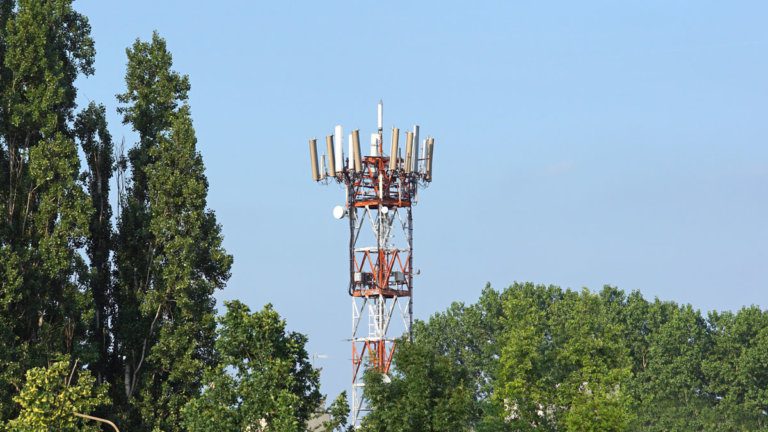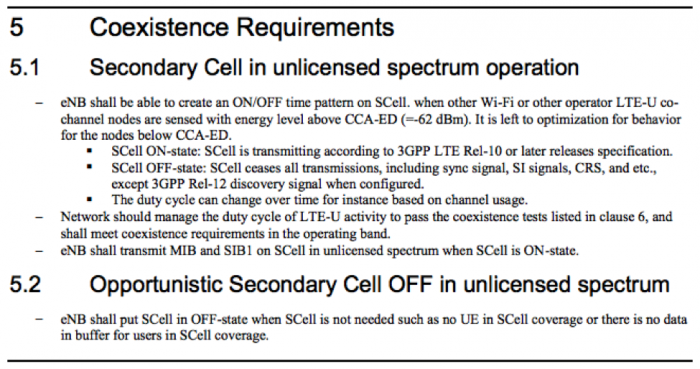Technical Blog
Can LTE-U Forum Specification Provide Fair Coexistence?

At CableLabs, we have been deeply engaged in ensuring that Wi-Fi and other technologies continue to thrive as LTE mobile technology is newly brought in to unlicensed spectrum. We have participated in the international standards process at 3GPP, and we are glad to say that there has been some progress by that body to lay the groundwork for reliable coexistence with Wi-Fi.
But unfortunately, when it comes to development of LTE-U – a different form of unlicensed LTE being developed outside of international standards for the US market – we haven’t been in the “club” -- and a small club it is. Back in 2014, Verizon created the LTE-U Forum along with Alcatel-Lucent, Ericsson, LG Electronics, Qualcomm, and Samsung. The goal of this ad-hoc group is to develop a form of unlicensed LTE, using different, and lesser, coexistence features than are required to protect European and Japanese broadband consumers.
Let’s recap: We know that there are different approaches to enabling LTE in the unlicensed band. Licensed-Assisted Access (LAA) is the version that the cellular industry standards body (3GPP) has been working on for the past year, and is nearing completion. Its coexistence measures start with the most fundamental coexistence procedure, “listen before talk”, or LBT. LBT refers to the 20+ pages of very specific algorithmic channel access contained in the nearly 3,000 page IEEE standard for Wi-Fi, which ensures that diverse users of shared spectrum do not talk over one another, and that all have equal and fair chance of accessing the spectrum. Many companies with a stake in the ground are participating; work is currently going on at the 3GPP to attempt to achieve a consensus-driven, fair coexistence protocol. Though work remains in the final stretch to realize win-win outcomes, it appears that 3GPP is headed toward adopting Wi-Fi-like coexistence features, as the IEEE urged at their recent presentation to the group in Beijing. If realized, that would ensure compatibility between LAA and Wi-Fi – at least in Europe and Japan. We welcome the collaborative process within 3GPP, and would encourage active collaboration with outside stakeholders as well, since this is shared unlicensed spectrum, after all. In particular, 3GPP should work more closely with the IEEE in order to ensure the 3GPP LAA specifications incorporate fair coexistence when completed.
In contrast, LTE-U, the non-standard US version, is taking a wholly different approach – both in process, and in substance. LTE-U is being developed outside of the 3GPP standards process, even though the same companies in the LTE-U Forum are also active in 3GPP. And it is taking an entirely different approach to coexistence, using a carrier-controlled on/off switch known as “duty cycling” instead of reliably fair listen-before-talk. Here, LTE turns on to transmit for some time determined by the wireless carrier, then switches off for some period of time, again determined by the carrier. It is during this “off” period that other users such as Wi-Fi can have the chance to access the channel, illustrated in Figure 1.
Figure 1
Earlier this year, the LTE-U Forum published a set of technical reports and specifications, including a document known as the “coexistence specification” (SDL Coexistence Specification v1.2, henceforth referred to as the “coexistence spec”), which governs the behavior of LTE-U. One might expect that the coexistence spec would contain requirements consistent with the various features that the LTE-U Forum has talked about on numerous occasions, such as their July presentation to the IEEE, or their recent letter to the FCC. But unfortunately, it contains none of this detail.
This is confusing, since we hear so much from LTE-U Forum companies about specific features that they envision and tests that have been run against parameters that they desire. So, to make things clear, Figure 2 below was taken directly from the LTE-U Forum spec, and contains the entirety of the coexistence requirements for LTE-U.
Figure 2
LTE-U Forum coexistence requirements simply entail an ability to duty cycle when it senses other operators are present. There is no requirement to share fairly in time, to avoid interrupting Wi-Fi transmissions mid-stream, or to adapt to different levels of Wi-Fi usage and traffic. And note that, in the ‘off’ state, LTE-U may still send discovery signals that can also interfere with Wi-Fi.
The LTE-U Forum coexistence specification does contain several test cases that envision configurations that are more specific. They are limited, however, and fail to reflect the range of circumstances in which LTE-U will be deployed, such as crowded street corners. But more importantly, these test cases in no way dictate how LTE-U will actually be deployed in the market, since that is how loosely the coexistence requirements are written. To quote directly, “Network should manage the duty cycle of LTE-U activity to pass the coexistence tests…”. It should. But it apparently isn’t required.
To ensure fair coexistence, the test cases should verify the amount of Wi-Fi performance impact due to LTE-U is limited and fair, based on the traffic demands on the channel. A few test cases check for Wi-Fi performance to be ≥ 4Mbps. But let’s be realistic, the 4Mbps performance target rather lowballs what Wi-Fi can do today. The latest generation of Wi-Fi is designed for gigabit speeds.
There are no requirements for determining or limiting duty cycle parameter values, and no rationale or method indicated to select these duty cycles in the test cases. Instead, the specification leaves the configurability of the duty cycle parameters to the discretion of the network operator or vendor, and an LTE eNodeB (the base station used in LTE networks) can pass the coexistence evaluation if it can simply show that it can manage the duty cycle. Consequently, whoever gets to control the duty cycle effectively controls the use of the channel. Now how is that for fairness?
We Need “Listen-Before-Talk”
The premise of LTE-U à la LTE-U Forum is to duty cycle the LTE in unlicensed bands in order to coexist with Wi-Fi. The fundamental problem here is that LTE-U does not “listen before talk,” a most basic politeness protocol; instead, LTE-U “listens and talks anyway” regardless of whether somebody else is talking or not. Put another way, once the LTE-U node determines the duty cycle parameters, the coexistence spec allows the node to transmit uninterrupted for an undefined period of time regardless of other network traffic on the channel.
There seems to be consensus all over the world that LBT is a fundamental coexistence requirement. The cellular industry itself (3GPP) has explicitly rejected non-LBT based approaches to the LAA standard, and regulations in the EU and Japan require LBT.
CableLabs encourages the LTE-U Forum to follow the 3GPP’s lead. The open standards development process has been successful in vetting new innovations and producing broadly supported solutions. True collaboration with IEEE and others will ensure that the unlicensed bands can continue their successful framework of self-regulation. Shared spectrum requires shared responsibility. The Wi-Fi industry is working to ensure unlicensed LTE is developed in a manner that maximizes use of spectrum and ensures win-win outcomes for consumers. Our goal is to continue the progress of wireless broadband, in all its forms.
Bernie McKibben, Distinguished Technologist, and Rob Alderfer, VP Technology Policy also contributed to this article.
Jennifer Andreoli-Fang is a Principal Architect at CableLabs.



